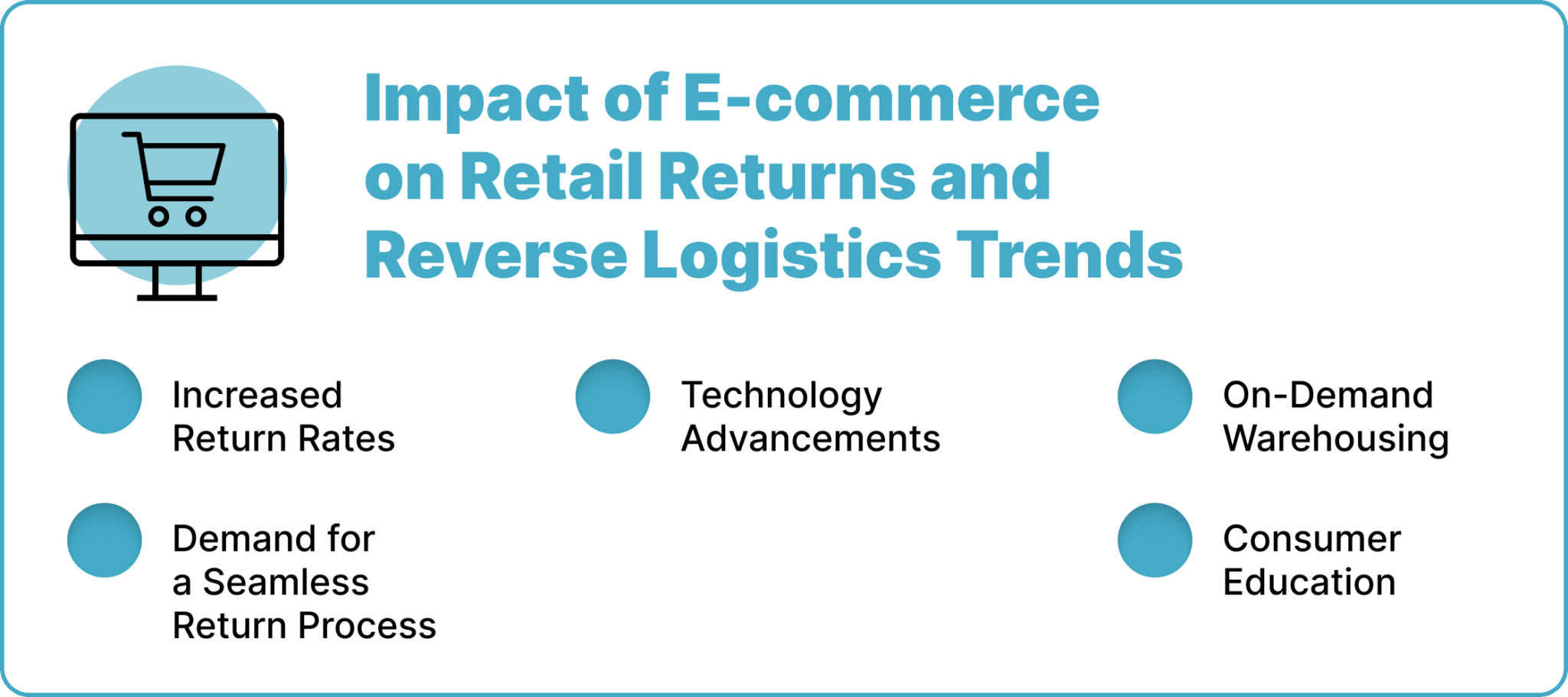Impact of E-commerce on Retail Returns and Reverse Logistics Processes

The impact of e-commerce on retail returns and reverse logistics cannot be understated, especially considering that reverse logistics is one of the foundational pillars that makes e-commerce possible.
Retail returns are not new, though. Before the advent of e-commerce, the concept of returns was much more simplified than the version we have today. As the e-commerce industry grew, customers leveraged the possibility of product returns to guarantee value for money. Ultimately, this has resulted in an increase in the volume of returned goods over the years.
While customers want convenience in their order-to-delivery cycle, getting what they ordered trumps that. Retail returns and reverse logistics ensured customers could purchase from e-commerce stores because they knew they could always return it if they had to.
In this article, we dive further into the impact of e-commerce on retail returns and the reverse logistics process. We will also explore some trends and challenges businesses face as they manage returns.
Impact of E-commerce on Retail Returns and Reverse Logistics

E-commerce has become a behemoth of an industry, projected to reach 47.7 trillion in 2030. Thanks to this growth, retail returns and reverse logistics have also become significant as one of the lynchpins to e-commerce success.
Here is how the rise of e-commerce has impacted retail returns and reverse logistics:
Increased Return Rates
The overwhelming success of the e-commerce industry has meant higher volumes of returns. Considering the sheer bulk of orders e-commerce businesses must fulfill, returns occurrences are a no-brainer as retailers have to battle internal errors and changes in customer expectations. Some are picky and some have buyer’s remorse, eager to return their orders.
While e-commerce businesses can do something about internal errors and have mostly done so by investing in strategies and logistics software that could streamline operations, they often cannot do anything about the customers.
Demand for A Seamless Return Process
Because of how vital the reverse logistics process is to the e-commerce industry and customers, there has been an increased consumer demand for a seamless returns management process. Customers want easy-to-navigate returns processing options, and businesses want a returns management operation that ensures they can properly sort, dispose, or reuse returned goods. They also wish to have a returns management system that will cost them less, considering that most ‘returns’ are free.
Technology Advancements
Modern logistics and supply chain operations are interwoven with technology solutions that help optimize and improve the outcome of each embedded process. The reverse logistics process is no exception. Earlier, we highlighted the increased return rates and the demand for seamless returns processes. However, technology integration and advancement are some of the ways these e-commerce platforms can enhance retail returns and reverse logistics operations.
Today, you have technology solutions like automation, predictive analysis, machine learning, and other applications that enhance returning, sorting, disposing, and allocating resources through robust returns management and inventory management software.
On-Demand Warehousing
Unlike everyday sales, customer returns can be challenging to predict or forecast. This means a lack of adequate planning and utilization of resources to manage the returns process. Some businesses invest in warehouses that are too big and become redundant, while others invest in warehouses that become too small, leading to inefficiency and a prolonged process.
With on-demand warehousing, e-commerce platforms and businesses can access warehouse solutions that allow them to scale up and down at will. With on-demand warehousing, these online retail stores can rent warehouse spaces without a long-term commitment. The process is cheaper, more efficient, and scalable for these e-commerce platforms.
Consumer Education
While e-commerce businesses can take steps to reduce the internal errors in their operations that cause customers to return goods, doing the same for the consumer can be somewhat challenging. However, with consumer education, these online platforms can dent that particular problem.
E-commerce platforms leverage consumer education to show customers how to order the right products. This could be anywhere from fashion to gadgets, electronics, and groceries. Consumer education helps these stores explain the meaning of some of the information displayed. It also allows the consumer to get familiar with the returns process, the available options, benefits such as store credit, and how to start processing returns.
Retail Returns and Reverse Logistics Trends

Because of the rise of e-commerce, reverse logistics operations have had to adapt to save cost, enhance customer experience, and save the e-commerce businesses some logistics costs. Some of these trends are:
Remanufacturing
Returned items or products can often be stripped for parts and used as raw materials to produce other goods. E-commerce businesses and platforms with manufacturing arms (especially those in the electronics industry) increasingly rely on these concepts to save money while improving their access to raw materials.
Sustainability
The sustainability push is more intense than ever. Customers and the government are increasingly demanding of its business. Unfortunately, if left unchecked, the reverse logistics process can majorly contribute to greenhouse gas emissions. Logistics is already responsible for 8% of that. Without integrating sustainability initiatives such as route planning, the operation will get out of control and begin negatively impacting the environment much more than it is today.
Transparency
Transparency is a significant factor in the lives of e-commerce businesses. It allows the companies to communicate effectively with the customers, and it will enable them to collaborate efficiently with 3PL (third-party logistics providers). Today’s reverse logistics operation requires a great deal of transparency if businesses look to optimize the entire process.
Challenges Plaguing Retail Returns and Reverse Logistics

The competition in today’s economic and supply chain landscape can be quite cutthroat. This means businesses must streamline and optimize processes like reverse logistics and retail return.
Hidden Costs
Although the returns management process is the cornerstone of e-commerce success, it is also free. That means the logistics, sorting, and disposal are done at the platform’s dime. The cost could add up as soon the sales continue to increase, leaving these businesses going around in the same spot. However, with tech solutions like route planning and automation of the reverse logistics processes, including sorting and disposal, much of these costs will be saved.
Logistical Processing Challenges
E-commerce platforms sometimes need help to streamline the logistical process involved in the returns management operation. This is due to several reasons, including focusing on last-mile to customers, neglecting the reverse logistics process, lack of understanding of customer behaviors, and lack of expertise.
Inventory Management Challenges: Properly Stocking Products
One of the biggest challenges in retail logistics is managing inventory efficiently to meet fluctuating customer demand. Overstocking ties up capital, while understocking can lead to missed sales opportunities and dissatisfied customers. Pre-orders give businesses valuable insights into customer interest, enabling them to better forecast demand and stay properly stocked.
How ReverseLogix is Helping E-commerce Platforms Establish Seamless Returns Management Operations
Whether selling to other businesses or consumers, the e-commerce platform is quickly becoming the preferred mode for many organizations. The recent pandemic also helped to solidify this. However, with more e-commerce platforms springing up, the reverse logistics process cannot be ignored.
Enhanced reverse logistics operations lead to enhanced customer service, which helps to build trust and loyalty. The good news is that with ReverseLogix, these e-commerce platforms have a solution to help them streamline the entire process. Our e-commerce returns management software is smarter, faster, and more flexible than the traditional returns process. Connect with us today to make a difference to your returns management and view our pricing plans.
Frequently Asked Questions
Q1: How has e-commerce changed the landscape of retail returns and reverse logistics?
A: By making buying and selling easier and much more simplified, e-commerce has significantly increased sales volume and order return rates.
Q2: How does effective reverse logistics impact customer satisfaction in e-commerce?
A: Effective reverse logistics processes, such as streamlined returns management and hassle-free return policies, ensure that customers can engage the returns process seamlessly. These also enhance the customer satisfaction and build trust.
Q3: How does e-commerce impact sustainability in reverse logistics?
The volume of transportation and packaging in the e-commerce business can have environmental implications. Retailers can explore route planning and sustainable packaging alternatives to mitigate these environmental impact implications.
Q4: What role does data analytics play in optimizing reverse logistics for e-commerce?
With data analytics, retailers will gain useful insights into return trends. It also allows them to analyze customer feedback and behavior, and product performance, allowing them to make informed decisions. Some of these decisions will cut across inventory management, pricing strategies, and return policies. They can use the information and these valuable insights to understand customer expectations, identify opportunities for streamlining the reverse logistics processes, and reduce costs.
